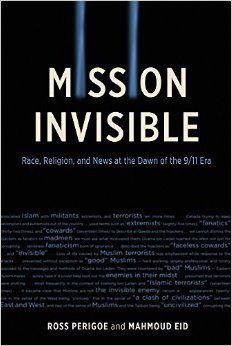Mission Invisible concerns itself with the media representation of Muslim communities immediately after the events of Sept. 11, 2001.
[[{“fid”:”4078″,”view_mode”:”default”,”fields”:{“format”:”default”,”field_file_image_alt_text[und][0][value]”:””,”field_file_image_title_text[und][0][value]”:””},”type”:”media”,”link_text”:null,”attributes”:{“height”:”346″,”width”:”232″,”style”:”width: 232px; height: 346px; float: right; margin-left: 10px; margin-right: 10px;”,”class”:”media-element file-default”}}]]By Tamir Arviv and Minelle Mahtani
Ross Perigoe and Mahmoud Eid, Misson Invisible: Race Religion and News at the Dawn of the 9/11 Era (UBC Press, 2014). Paperback, $34.95.00
Mission Invisible concerns itself with the media representation of Muslim communities immediately after the events of Sept. 11, 2001. Written by the late Ross Perigoe, who taught journalism at Concordia University, and Mahmoud Eid, an associate professor at the Department of Communication at the University of Ottawa, it focuses on The Montreal Gazette—owned, at the time, by the CanWest Global media empire. It refers to the way in which the misrepresentation of Muslim communities in the Gazette has rendered their cultural and ideological diversity invisible.
According to Perigoe and Eid, the final grade for the Gazette’s performance is an F, particularly in relation to demonstrating journalistic leadership. Perigoe and Eid argue that the job of journalists at the newspaper was to challenge racist ideologies and anti-Muslim moral panic that were strategically spread by politicians following the 9/11 attacks. Unfortunately, the Gazette’s reporters failed in fulfilling basic journalistic duties to their readers by favouring the largely white voices of politicians and victims. Indeed, Perigoe and Eid find that the longest quotation from any Muslim person during the period of their study was from Osama Bin Laden’s “Declaration of the World Islamic Front of Jihad against the Jews and the Crusaders.”
According to the authors, the Gazette entertained its white readers, telling them what they wanted to know instead of what they needed to know, resulting in a racialized story of 9/11. From the first day after the events, the newspaper’s reporters used racially charged words such as “Islamic fundamentalists” or “Barbarians”—a word employed five times during the 20 days of their study and always in reference to Muslims.
The Gazette’s reporters further incited paranoia among readers by exaggerating the number of casualties of the attacks, prematurely declaring the death toll of the attack on the World Trade Center to be more than 6,000 (more than double the actual number of deaths) with no concrete evidence. They also relied on what the authors call “imaginative” narratives, such as the possible use of atomic bombs or the deployment of biological and chemical weapons by Islamic terrorists.
The examples of racially biased reporting are numerous, and they tell us a bigger story about similar patterns that reveal the state of Canadian journalism today. Perigoe and Eid argue that the Gazette’s initial reaction to the 9/11 attacks reflects the deeply ingrained ideology of white elite racism in most North American (and transnational) media. This ideology not only reproduces the racist attitudes towards Muslim communities but more generally reinforces the institutionalization of systemic racism in Canadian society.
Mission Invisible is a valuable resource for both media scholars and journalists interested in the relationship between media and the spread of racist attitudes. The authors refer to various media analysis studies in (mainly) the North American context, as well as introducing user-friendly explanations of key theoretical concepts such as racialization, orientalism and white normativity.
This theoretical and empirical richness provides insights into journalists’ important role in challenging the racially-charged rhetoric of politicians in times of crisis. Perioge and Eid also suggest new ethical practices for journalists along with a new “mission possible”: making the invisible visible. New hiring practices are considered, with an eye toward addressing the disproportionately low employment of visible minorities in Canadian media.
But diversity in and of itself means nothing, the authors write, “if the people hired think precisely as elite whites do.” Perigoe and Eid call on journalists to commit themselves to integrating anti-racist discourse into their writing, to ensure not only racial diversity in hiring but also the diversity of opinions and voices. As scholars of colour working on media and minority representation, we agree.
Ironically, one of the flaws with the book is what the authors themselves make invisible for the benefit of presenting a simple white vs. Muslim-Arab dichotomy. In a way, the emphasis on this binary throughout the book perpetuates the thinking that led to the invisibility of Muslims as faceless, homogenous others in the first place. We believe that it is crucial to unpack this binary by exploring how the attitudes of a diverse set of readers, who do not necessarily fall into one category or the other, are affected by racially biased reporting. But in general, the authors succeed in their mission of highlighting dangerous racial binaries in media coverage, while at the same time falling back too easily on those same binaries for the sake of a simple and compelling argument.
[[{“fid”:”4077″,”view_mode”:”default”,”fields”:{“format”:”default”,”field_file_image_alt_text[und][0][value]”:””,”field_file_image_title_text[und][0][value]”:””},”type”:”media”,”link_text”:null,”attributes”:{“height”:”849″,”width”:”827″,”style”:”width: 100px; height: 103px; margin-left: 10px; margin-right: 10px; float: left;”,”class”:”media-element file-default”}}]]Tamir Arviv teaches at University of Toronto. His research interests include transnational migration studies and critical race theory.
[[{“fid”:”4082″,”view_mode”:”default”,”fields”:{“format”:”default”,”field_file_image_alt_text[und][0][value]”:””,”field_file_image_title_text[und][0][value]”:””},”type”:”media”,”link_text”:null,”attributes”:{“height”:”500″,”width”:”333″,”style”:”width: 100px; height: 150px; margin-left: 10px; margin-right: 10px; float: left;”,”class”:”media-element file-default”}}]]Minelle Mahtani is an Associate Professor in the Department of Human Geography and Program in Journalism, University of Toronto Scarborough. She is a former national television news researcher and producer at the CBC, where she produced for both “The National” and “The History Project.” She is the author of the book, “Mixed Race Amnesia: Resisting the Romanticization of Multiraciality” (UBC Press 2014) and the co-editor of “Global Mixed Race” (NYU Press, 2014).

